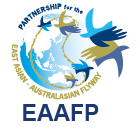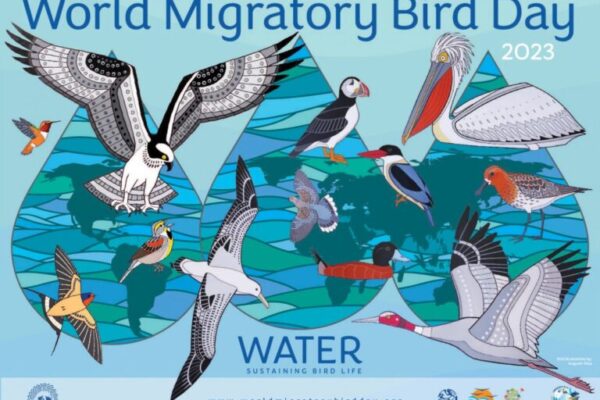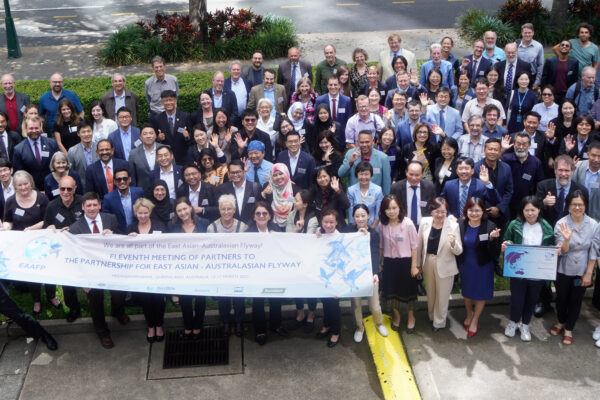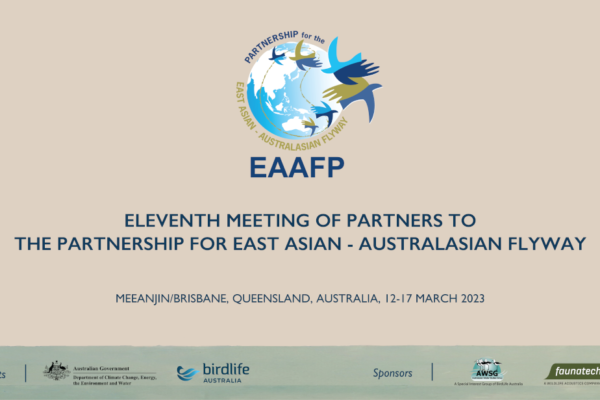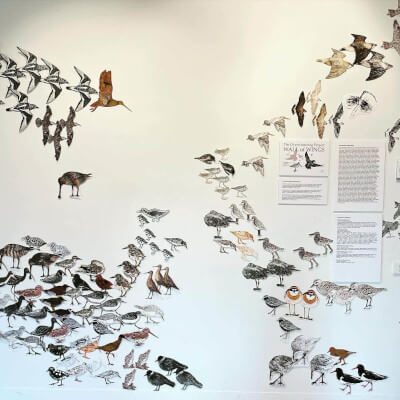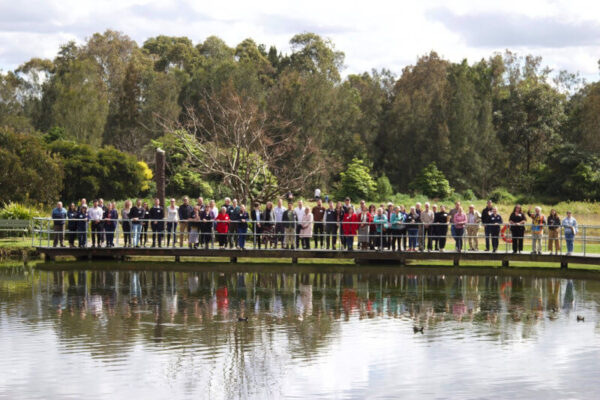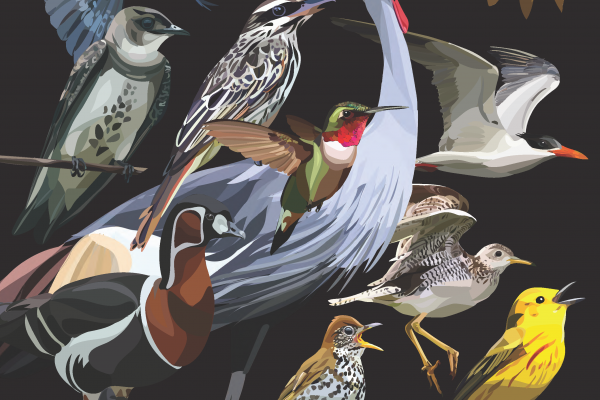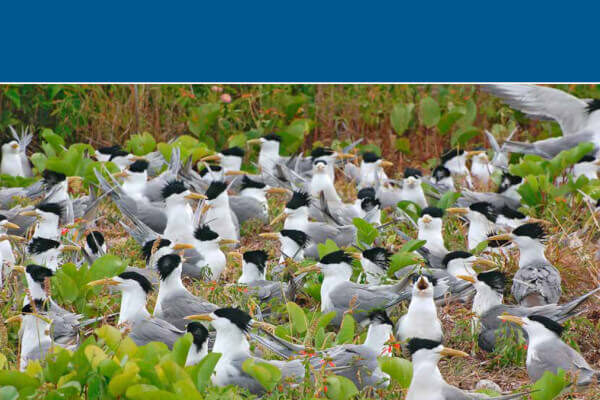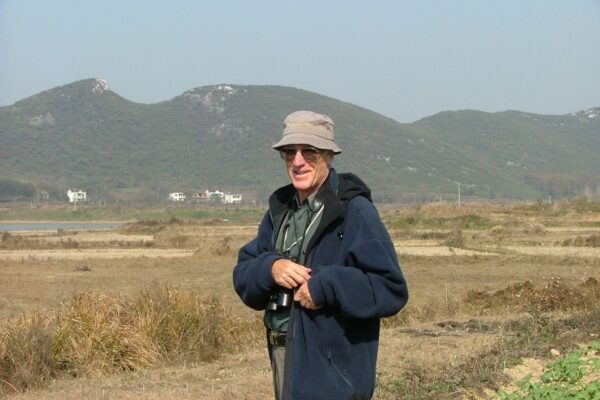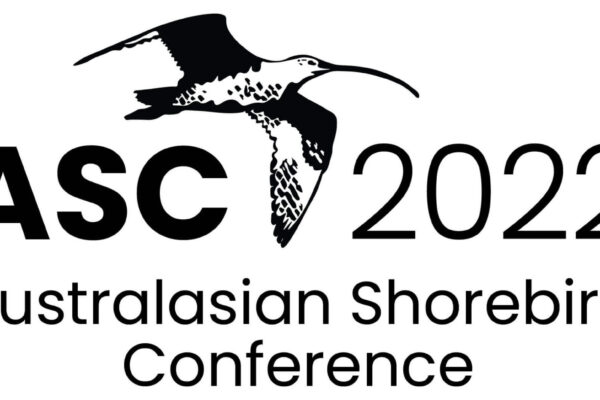-
World Migratory Bird Day 2023 highlights impact of the growing water crisis on migratory birds
BOULDER/BONN/INCHEON, 13 May 2023 – Water and its importance to migratory birds – and the increasing threats to both water quality and quantity - is the focus of this year’s World Migratory Bird Day, a global campaign that aims to raise awareness of migratory birds and the need for international cooperation to conserve them. Activities to mark the campaign will be held globally on two peak days in May and October under the theme “Water: Sustaining Bird Life” Water is fundamental to sustaining life on our planet. Migratory birds rely on water and its associated habitats—lakes, rivers, streams, ponds, swamps, marshes, and coastal wetlands—for breeding, resting, refueling during migration, and wintering. Yet increasing human demand for water, along with climate change, pollution, and other factors, are threatening these precious aquatic ecosystems. Headlines around the world are sounding alarm: 35 percent of the world’s wetlands, critical to migratory birds, have been lost in the last 50 years. Utah’s Great Salt Lake, the largest saltwater lake in the Western Hemisphere and used by more than a million shorebirds, is in danger of disappearing within five years. Across the Amur-Heilong Basin in Asia, climate change is amplifying the impact of habitat destruction by depleting natural water systems and depriving migratory birds of vital breeding and stopover site. These sobering examples go hand-in-hand with recent reports that reveal that 48 percent of bird species worldwide are undergoing population declines. Another poignant example is that of the Aral Sea shared by Kazakhstan and Uzbekistan. Once the fourth-largest lake in the world, it is widely regarded as one of the planet’s worst water-related environmental disasters. Soviet-era irrigation projects almost completely dried up the lake, which led to the loss of livelihoods for fishermen and farmers and the deterioration of public health due to toxic dust and reduced access to clean water. The impact has been severe for the communities around the lake, but also for migratory birds, which lost important food sources and a critically important stopover point on their journey. Another example is the Sahel, a vast semi-arid region in Africa: Prolonged periods of drought, deforestation, and overgrazing in the Sahel have led to the degradation of the soil and loss of vegetation, threatening the survival of both the local human population and wildlife, including migratory birds. Lake Chad, one of the largest water bodies in Africa in 1960, lost 90 % of its area, depleting water resources for local communities and also for many migratory birds. World Migratory Bird Day serves as an international call to action for the protection of migratory birds, whose ranges often span multiple countries, and are facing many different threats worldwide. The annual campaign is organized by the Convention on the Conservation of Migratory Species of Wild Animals (CMS), the African-Eurasian Migratory Waterbird Agreement (AEWA), Environment for the Americas (EFTA), and the East Asian-Australasian Flyway Partnership (EAAFP). World Migratory Bird Day 2023 will be officially held on 13 May and 14 October. The two days of World Migratory Bird Day reflect the cyclical nature of bird migration as well as the fact that there are varying peak migration periods in the northern and southern hemispheres. Events to raise awareness of migratory birds and the importance of water will take place all over the world including in local parks, nature centers, museums, libraries, schools, and other locations on these peak days and throughout the year. To learn more about this year’s World Migratory Bird Day campaign and actions to take, visit www.worldmigratorybirdday.org and EAAFP WMBD 2023 webpage: https://www.eaaflyway.net/world-migratory-bird-day-2023/ Also, please have a look of the Campaign Strategy for promoting World Migratory Bird Day, click [here]. For more resources, visit the Trello Board [here]. Message from the Partners of World Migratory Bird Day Convention on Migratory Species (CMS) “Water is essential for people as well as for migratory birds and other wild species of animals. Yet around the world, the availability and quality of water is under enormous pressure, with deeply concerning implications. The looming global water crisis requires urgent action by governments, businesses, local communities as well as individuals. Because migratory birds cross national borders and even continents, international cooperation is essential to ensure that actions are taken to conserve and restore important habitat for migratory birds, and to address the drivers of water loss, pollution, and climate change,” said Amy Fraenkel, Executive Secretary of the Convention on the Conservation of Migratory Species of Wild Animals (CMS). African-Eurasian Migratory Waterbird Agreement (AEWA) “The water crisis recently highlighted by the UN 2023 Water Conference also has a tremendous impact on migratory birds. In the Sahel in particular, many wetlands on which migratory waterbirds rely during the non-breeding period are shrinking. Water is a vital resource for all, local communities as well as birds. By reducing our consumption, combatting climate change, and managing wetlands wiser, we can improve the situation,” said Dr. Jacques Trouvilliez, Executive Secretary of the Agreement on the Conservation of African-Eurasian Migratory Waterbirds (AEWA). Environment for the Americas (EFTA) “World Migratory Bird Day 2023 spotlights the vital role that water plays in the survival of our shared birds. The focal species illustrated on the campaign poster depict the intricate bond each bird shares with water. The diminutive Rufous Hummingbird thrives on nectar-producing flowers that rely on water for their blooms, and the Dickcissel scours the grasslands for seeds that hold the moisture they need. White Pelicans and Ospreys seek their prey in freshwater lakes, while the magnificent Wandering Albatross and Atlantic Puffin remain at sea. WMBD is an opportunity to unify our voices for the conservation of migratory birds and to celebrate their spectacular journeys,” said Dr. Susan Bonfield, Executive Director at Environment for the Americas (EFTA). East Asian-Australasian Flyway Partnership (EAAFP) “This year's WMBD theme serves as a vital reminder of the linkage of migratory birds to the importance of protecting aquatic ecosystems and conserving wetlands. As birds such as threatened Spoon-billed Sandpiper, Dalmatian Pelican, and Sarus Crane migrate, they rely heavily on wetlands for survival. We must take urgent actions and collaborate at all levels, from citizens to among governments, to tackle the problems of saving water and aquatic ecosystem, and ensure that migratory birds continue to thrive.” Ms. Yeounhee Ahn, Deputy Executive of East Asian-Australasian Flyway Partnership (EAAFP).
Continue reading -
The East Asian – Australasian Flyway Partnership (EAAFP) kicked off the 11th Meeting of Partners in Brisbane, Queensland, Australia to jointly conserve migratory waterbirds from the most threatened flyway in the world
Group photo of EAAFP © EAAFP Secretariat On 13th March, the 11th Meeting of Partners (MOP11) of the East - Australasian Asian Flyway Partnership (EAAFP) officially kicked off in Brisbane, Queensland, Australia, under the theme “We are all part of the East Asian-Australasian Flyway!”. Co-hosted by the Department of Climate Change, Energy, the Environment and Water, Australian Government and BirdLife Australia, and sponsored by Australasian Wader Study Group and Faunatech, the meeting brought together over 150 participants from 18 national governments, inter-government organizations, international NGOs, site managers, experts and corporates. The delegates will lead the discussion on the eleventh key Draft Decisions to find a solution and better direction to conserve migratory waterbirds, their habitats and livelihoods in the Flyway. The meeting was opened with a traditional aboriginal Welcome to Country performance delivered by Tribal Experiences. The MOP11 was officially opened through welcome remarks by the co-hosts, Dr Ilse Kiessling, Assistant Secretary, Protected Species and Communities Branch, Biodiversity Conservation Division, Department of Climate Change, Energy, the Environment and Water, and Prof. Martine Maron, President of BirdLife Australia. Dr Ilse Kiessling, Assistant Secretary, Protected Species and Communities Branch, Biodiversity Conservation Division, DCCEEW © EAAFP Secretariat Prof. Martine Maron, President of BirdLife Australia © EAAFP Secretariat "We are thrilled to bring together our partners from across the Flyway to share knowledge, learn from one another, and plan for the future of migratory waterbird conservation," said Martine Maron, President of BirdLife Australia, co-host of MOP11. "This meeting is a critical opportunity to engage with a diverse group of stakeholders and strengthen our collective efforts to protect the flyway." Dr. Musonda Mumba, Secretary General of the Ramsar Convention also delivered a recorded congratulatory message to EAAFP MOP11. After, Mr. Robb Kaler, Chair of EAAFP gave opening remarks, followed by a memorial ceremony dedicated to Dr. Lew Young, former Chief Executive of the EAAFP Secretariat, and Dr Evgeny Syroechkovskiy, former EAAFP Spoon-billed Sandpiper Task Force Chair and Focal Point of Russia. In his opening remarks, Mr. Robb Kaler, Chair of EAAFP said “No single country can conserve all the migratory waterbirds, only if we collaborate and amplify our effort can the waterbirds be conserved and wetlands be sustainably managers, “highlighted Mr. Robb Kaler, Chair of EAAFP. “I hope that this MOP proves to bolster the effort of the Partnership to continue their tireless work of preservation of migratory birds and their habitats within our precious Flyway.” Dr. Musonda Mumba, Secretary General of the Ramsar Convention © EAAFP Secretariat Mr. Robb Kaler, Chair of EAAFP © EAAFP Secretariat During the opening ceremony, the Partnership welcomed the two new Partners, Hong Kong Bird Watching Society and Mangrove Foundation, and 11 new Flyway Network Sites from Australia, Cambodia, China, Japan, Myanmar and the Republic of Korea since the 10th Meeting of Partners (MOP10). Two Sister Sites agreements were celebrated between Incheon, Republic of Korea and Hong Kong S.A.R., China, as well as Saga City, Japan and Alaska, U.S.A. Mr. Yat-tung Yu, Director of new Partner, Hong Kong Bird Watching Society (HKBWS), said, “Hong Kong lies in the middle of the East Asian-Australasian Flyway. Thousands of waterbirds including globally threatened Black-faced Spoonbill, Spoon-billed Sandpiper and Saunders’s Gull utilise Mai Po Inner Deep Bay Flyway Site for wintering and passage. The HKBWS is privileged to join the EAAFP and eager to work with other partners for more collaborative and impactful conservation activities to protect waterbirds and their habitats with local, regional and global perspectives." Dr. Baohua Yan, Secretary-general of new Partner, Mangrove Foundation (MCF), expressed “MCF is a leading wetland and biodiversity conservation charity in China, with the mission of living wetlands and sustainable future. It employs a social participation model for nature conservation through adaptive management of protected areas, CEPA (wetland education and public engagement), network building, grantmaking and international collaboration. It does this through strategic projects, such as Saving the Spoon-billed Sandpipers, Mangrove Conservation and Restoration, Active Wetland Management in Shenzhen Bay, and China Wetland Center Network.” Mr Yat Tung Yu, Director of Hong Kong Bird Watching Society, New Partner to EAAFP © EAAFP Secretariat Ms. Sun Lili, Founder, and Board Member, Mangrove Foundation, New Partner to EAAFP © EAAFP Secretariat Following the Ceremonies, Prof. Richard Fuller from the University of Queensland gave a keynote presentation, illustrating the critical situation that some shorebirds are declining, and how we can save the migratory waterbirds. After the opening ceremony, two side events to introduce and discuss the revised CEPA Action Plan and the new Guidelines of National, Site and Sister Site Partnerships, as well as "Green Energy and Conservation of Migratory Birds" respectively. In the afternoon plenary session, the Partners adopted the Rules of Procedure and elected Australia as Chair and U.S.A. as Vice Chair to the MOP11. At the end of the first day, BirdLife Australia organized the opening performance, music played by Bowerbird Collective, with a song “Life on Land's Edge “, and the participants to MOP11 were treated to the opening reception hosted by the Australian Government and BirdLife Australia. In the upcoming meeting, Partners and collaborators will contribute to discussing Document papers and 11 Decision papers, which will enhance efficiency in Partnership operation, including CEPA Action Plan, and establishing the new guidelines of national, site and Sister Site Partnerships, Population Estimates and Trends of Migratory Waterbird Populations. In the following days until 17th March, there will also be 11 side events organized to foster collaboration, knowledge-sharing, and strengthening the Partnership in the future, and working towards synergizing the work of EAAFP with Multilateral Environment Agreements (MEAs) and different regional conservation initiatives and mechanisms. Opening performance "Life on Land's Edge “ music played by Bowerbird Collective © EAAFP Secretariat Learn more about MOP11 and updates: https://www.eaaflyway.net/11th-meeting-of-partners-mop-11/ Photo album on 13th March: https://www.flickr.com/photos/eaafp/sets/72177720307070189/
Continue reading -
Over 150 delegates meet in Brisbane, Australia to discuss the conservation of migratory waterbirds
The East-Australasian Asian Flyway Partnership (EAAFP), a partnership of governments, NGOs, and experts working to conserve migratory waterbirds and their habitats, is pleased to announce the upcoming 11th Meeting of Partners (MOP11) in Brisbane, Australia, from 12th to 17th March, 2023. The global migratory waterbird population is experiencing declines of up to 80% over the last 30 years, with the East Asian-Australasian Flyway (EAAF), which stretches from the Russia Far East and Alaska to Australia and New Zealand in the south, having the highest proportion of globally threatened species among all flyways. The destruction and degradation of wetlands along the Flyway impact the waterbirds’ survival. The MOP11 is co-hosted by the Department of Climate Change, Energy, the Environment and Water of the Australian Government and BirdLife Australia, and sponsored by the Australasian Wader Study Group and Faunatech. The theme of the MOP is “We are all part of the East-Asian Australasian Flyway!” and brings together over 150 partners and collaborators from across the 18 range countries and beyond to discuss the latest developments in migratory waterbird conservation. Established in 2006, the EAAFP aims to conserve migratory waterbirds, their habitats and the livelihood of local people depending on them along the East Asian-Australasian Flyway (EAAF). The Partnership includes government bodies, inter-governmental organizations, INGOs, international organizations, corporations, scientific experts, site managers, and local communities. The importance of protecting migratory waterbirds and wetlands The East Asian-Australasian Flyway is home to over 50 million migratory waterbirds of more than 210 species, using various types of wetland habitats to breed, rest and forage. Many of them, such as Bar-tailed Godwit, and Far Eastern Curlew, fly over thousands of kilometres for migration twice every year. Globally, wetlands are being cleared and damaged, and their water is diverted and drained for agriculture or aquaculture, and to make way for development. They are also threatened by the growing impact of climate change, like increasing droughts and fires, as well as growing pressures from overgrazing and invasive species, and more recently diseases like Avian Influenza. 11th Meeting of Partners encourages synergies to take conservation actions This upcoming meeting is the first since the establishment of the EAAFP Strategic Plan 2019 – 2028. It will be an opportunity to understand how the Partners are aligning our actions to the strategic plan, and allow participants to share knowledge and experiences, discuss new and ongoing initiatives, and plan for future conservation efforts. The week-long meeting will feature discussions of key issues raised by Partners, and interactive side events covering regional collaboration, allowing partners to exchange ideas and build strong networks to support the partnership's work. In addition, MOP11 will include a field trip to the Moreton Bay wetland, a Flyway Network Site of the EAAFP, and critical for migratory birds like the endangered Far Eastern Curlew. About MOP11, click here. Far Eastern Curlew © Maria Coleman
Continue reading -
Celebration of World Migratory Bird Day 2022 in Australia: Stories of Home
In the 2022 WMBD October event, Australian Artist Kate Gorringe-Smith organised an interactive exhibition “Stories of Home” at the Joel Gallery, Louis Joel Arts and Community Centre. In the…
Continue reading -
Conserving Critically Endangered Christmas Island Frigatebird
The Christmas Island Frigatebird (Fregata andrewsi) is a globally threatened migratory seabird; listed as Vulnerable by the International Union for the Conservation of Nature (IUCN). In Australia, the species…
Continue reading -
The Hunter Estuary Forum 2022
0 Participants of Hunter Estuary Forum ©Hunter Wetlands Centre The Hunter Estuary in Newcastle NSW, Australia is a place of great contrasts. It hosts the most important estuary in NSW for migratory shorebirds, the Hunter Estuary National Park and the Hunter Estuary Ramsar site, which includes Hunter Wetland Centre, Australia’s first dedicated wetlands centre. The Hunter Estuary is also home to the largest export facilities for both thermal and manufacturing coal in the Southern Hemisphere. Since the early 1980’s the Hunter Estuary has benefitted from four significant wetland restoration projects, beginning with the restoration of a small area of drained and degraded wetlands which was to become Hunter Wetlands Centre. Each of these restoration projects took lessons from what had gone before. Most importantly strong social partnerships among community conservation organisations, governments and industry organisations underpinned these achievements. Earlier this year Hunter Wetlands Centre proposed the idea for a Hunter Estuary Forum to commemorate the 20th anniversary Hunter Wetlands Centre being listed as a Ramsar site and to open a conversation among estuary stakeholders that have a role as managers, knowledge holders, service providers and educators for the estuary. Such an event would provide the opportunity to reconnect with our shared conservation history The forum program was designed in partnership with Australian Ramsar Administrative Authority (Federal Department of Climate Change, Energy, Environment and Water), NSW National Parks and Wildlife Service and Hunter Bird Observers Club. EAAFP also came on board in recognition of the Hunter Estuary as Site Number 10 on the East-Asian Australasian Flyway Site Network. On 31 August, participants from Local Government, State Government, Industry groups and non-government conservation organisations joined together at Hunter Wetlands Centre to hear from both keynote speakers and estuary locals from many sectors on the priorities and the challenges for the Hunter Estuary. The response to the event and the engagement on the day was very encouraging. It was clear from discussions from the floor and in break-out groups that collaboration across sectors has been a missing ingredient in recent years. There was strong concensus among participants on the need for a collaboration mechanism that could provide a neutral space where shared objectives might be developed. The Hunter Estuary and surrounding catchment has a unique opportunity to demonstrate a collaborative and cooperative approach to conservation and management of our coastal environment. We have the opportunity to leverage the science and knowledge underpinning the Hunter Estuary to guide coastal wetland restoration and identify transferrable learnings that can be used in other coastal communities. There was strong support for continuing the Hunter Estuary Forum process where some of these threads can be developed and it is hoped that a follow-up event can be held by mid 2023. Through sharing knowledge and experience, we may be better able to consider innovative management models that can deliver mutual benefits for our estuary and its stakeholders. Article prepared by: Christine Prietto, HWCA Ramsar Officer, Hunter Estuary Forum Convenor, Ramsar NGO CEPA Focal Point, Australia Official website of Hunter Estuary Forum: https://wetlands.org.au/hef/
Continue reading -
-
Australia’s Wildlife Conservation Plan for Seabirds
At the national level in Australia, the Environment Protection and Biodiversity Act 1999 (EPBC Act) provides for the development and…
Continue reading -
Mark Barter Travel Award and Australasian Shorebird Conference 2022
Following the announcement of the Australasian Shorebird Conference (ASC) organized by Australasian Wader Study Group and Queensland Wader Study Group, to be held virtually on 29-30 October 2022 (link), please mark the date and stay tuned for further information about the program, registration arrangements, and call for abstracts will be forthcoming in the near future. In line with the ASC, the Mark Barter Travel Award nomination has been launched. Mark Barter Travel Award The AWSG Committee will again be offering an Award to honour the late Mark Barter. Shorebird workers and others will be aware of the tremendous contribution that Mark made to the understanding and conservation of shorebirds in the East Asian- Australasian Flyway over many years. In view of Mark’s substantial contributions through monitoring, training and education focused on the Yellow Sea region, this Award seeks to build on Mark’s work by encouraging the further experience and development of young people who have demonstrated an interest in this work. Scope of Award The recipient of this Award will be sponsored to participate in the 2022 Australasian Shorebird Conference (ASC) which will be held online 29th – 30th September. The Award will cover the cost of registration for the recipient. Selection Criteria As the Award is focused on the Yellow Sea region, applications are sought from interested people from China, the Republic of Korea and the Democratic People’s Republic of Korea. Applicants should have a demonstrated interest in shorebirds and supporting their conservation through a scientific approach. The successful applicant is strongly encouraged to give an oral or poster presentation to the ASC. Applications Applications with supporting information should be forwarded to awsgconference@gmail.com by 1 August 2022. At least two referees should be nominated in the application. Mark Barter. Photo courtesy: Australasian Wader Study Group
Continue reading -
Announcement of 12th Australasian Shorebird Conference
The 12th Australasian Shorebird Conference will take place from 29-30 October 2022, hosted jointly by the Australasian Wader Studies Group and the Queensland Wader Studies Group. We are pleased to announce that the Conference will be an online event, in hopes of encouraging broad participation from around Australia and across the East Asian – Australasian Flyway. The theme for this Conference is “Global Strategies Local Actions” and through the Conference program, we will look at what has been happening across the East Asian – Australasian Flyway since the 11th Australasian Shorebird Conference held in 2018. We have developed an exciting program on shorebird natural history, counting, research and local conservation action over the last 4 years to give you a fascinating insight into the knowledge and understanding of shorebirds as well as the work being done towards their conservation. We know of the many ongoing challenges that shorebirds face, including loss of habitat, hunting, pollution and competition for food resources. Add to that the increasing threats from climate change and greater impacts from a growing human population in the Flyway, their world becomes more and more uncertain. Strong efforts are being dedicated at the global and local level to understanding, raising awareness for, and addressing the problems facing shorebirds. You will see this reflected through the range of exciting sessions during the two days. Knowledge and action go hand in hand, and we will see all the efforts that have been put in to achieving better outcomes for shorebirds. All keen “shorebirders” will find the program of interest however you are engaged with our amazing shorebirds. We encourage you to register and join the Conference to learn more about and be part of the wonderful world of shorebirds and those seeking to ensure their conservation. Conference official website, visit here. Abstract submission deadline: 15 August, 2022 Participation registration deadline: 30 October, 2022 Mark Barter Travel award information, check here.
Continue reading
